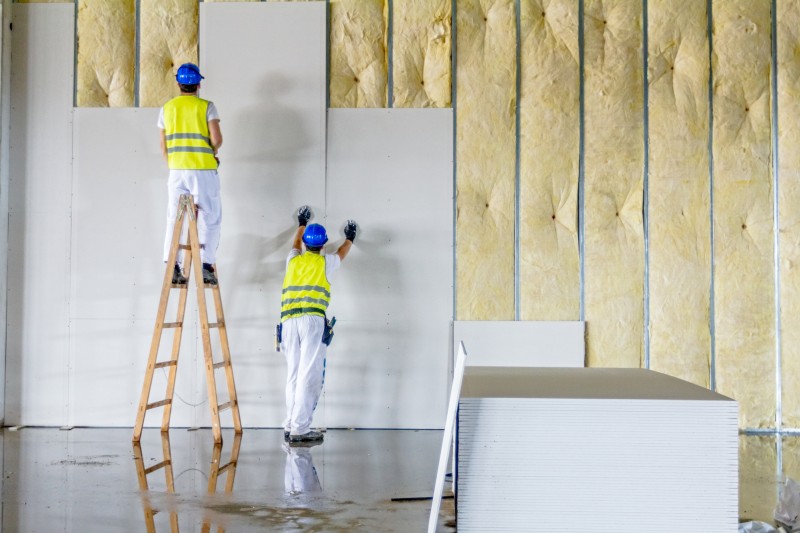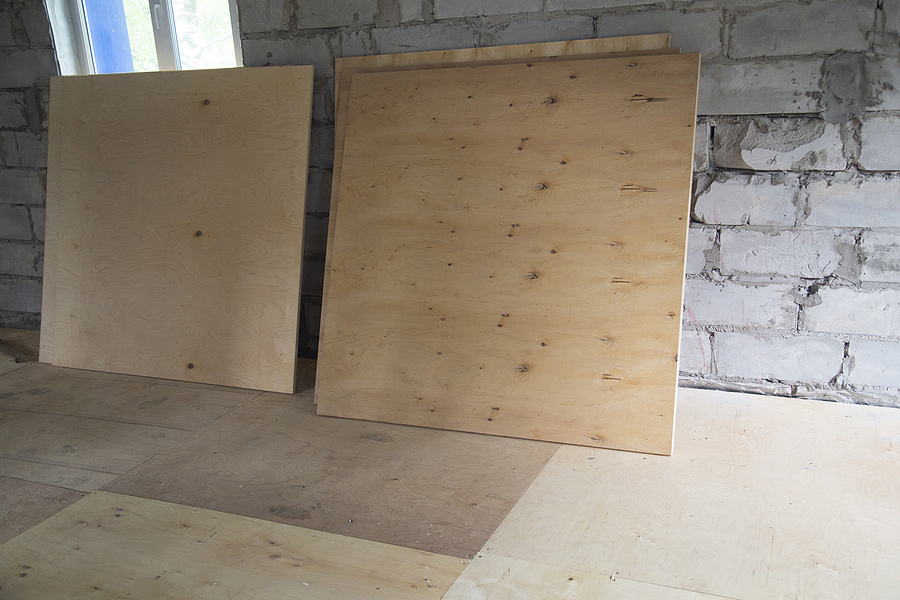Today’s residential interior wall scene is anything but boring. Options are endless, especially if you have a sizeable budget for your home interior and exterior projects.

Bottom line is that you can find many material options for interior walls, and two good ones include drywall and plywood.
These two wall materials have been around for very long and also you won’t have a problem finding contractors skilled at installing either.
We take a deep dive into drywall vs plywood to help you figure out which makes the most sense for your unique abode.
What is Drywall?
Contractor Philip Schmidt knows so much about drywall, he could be considered a historian. His article for the website Hunker.com is remarkably comprehensive for anyone eager to try their hand at this 100-year+ method of finishing interior walls.

Drywall is sold in panels made up of layers of paper bonded with “a slurry of dense liquid gypsum” and then sealed by “a center layer of aerated gypsum and topped with another dense layer of gypsum before more paper is sandwiched on top.”
Sheets are extruded to remove moisture and achieve universal thicknesses and ends are trimmed to uniform lengths.
Invented and patented by Augustine Sackett in 1894, you could run into these alternative name when you shop for drywall:
- sheetrock;
- gypsum panels;
- plasterboard;
- wallboard;
- green boar (the moisture-resistant drywall used to finish rooms like bathrooms where excess moisture is likely to occur.
Sold in 4-foot-wide panels, lengths range between 8- and 16-feet to suit various ceiling heights.
What is Plywood?
If you think that drywall comes in myriad types, wait until you see how many plywood types are currently found on the DIY market (and other alternatives as wells).

All plywood starts off as thin wood veneers positioned at different angles to produce a grain mix that adds strength and durability before it’s pressed and heated using binders to bond each section.
Strong and versatile, the plywood-making process must be precise so the sections don’t contract or expand, results that could trigger warping, twisting, cracking, breaking and shrinking.
The more plies, the better the quality, so look for at least 3-ply when you shop and while you’re there, you may find out how many other names manufacturers use for these plywood sections, including Veneer core plywood; MDF core; Lumber core plywood and ApplePly, some of which are proprietary brands.
If you’re doing more than the walls, you may also need exterior sheathing plywood and subfloor plywood to complete the job.
Additionally, plywood comes in grades that denote “the physical appearance of the product. They range from Grade A to Grade D, the most superior being A.”
Finally, you’ll be asked to choose from these sizes when you shop:
- 4-feet x 8-feet;
- 4-feet x 9-feet and
- 4-feet by 4-feet.
Thicknesses range between 1/8-inch to more than 1.5-inches.
Pros of Drywall Compared to Plywood
Drywall has the following advantages compared to plywood:
- -Drywall is easier to cut, trim, hang and install.
- -Drywall is easier to fix than plywood if damaged; just patch and sand.
- -Drywall is cheaper than plywood.
- -Repairing drywall takes less time and requires less expertise.
- -Drywall isn’t subject to price fluctuations; plywood is.
- -Drywall offers a flat surface that’s easier to decorate with other wall covering materials.
- -Drywall is more fire resistant than plywood.
Cons of Drywall Compared to Plywood
Drywall has the following disadvantages compared to plywood:
- -Installing drywall isn’t a walk in the park.
- -Drywall is less durable than plywood over the long haul.
- -Drywall isn’t as hospitable to heavy wall hangings; you must drill through it to reach anchoring studs.
- -The average 4- x 8-foot sheet of drywall may weigh between 20 to 30 pounds more than plywood of the same size.
Pros of Plywood Compared to Drywall?
- -Plywood weighs less so it’s easier to transport and install.
- -Plywood grains provide a warm, natural look.
- -Plywood comes in varying grades so you can choose the one that suits your budget.
- -Installation can be faster because unlike drywall, no taping and finishing are required.
- -Even the thinnest plywood is considerably stronger than drywall.
- -A thin coating of varnish is all that’s needed to give walls a finished look.
- -Plywood is an ideal wall material for garages; it’s easier to hang tools and household goods.
Cons of Plywood Compared to Drywall?
- -It’s harder to repair damaged plywood than it is to repair drywall.
- -Plywood’s texture is bumpy; attaching wall coverings could cause air bubbles.
- -Plywood installation may require unique fasteners that can be hard to hide.
- -Plywood must be acclimated to a room before installing. This could take 24 hours.
- -Even inferior plywood grades tend to cost more than drywall installs.
- -Plywood is a bigger fire hazard than drywall.
Average cost of Drywall
According to HomeAdvisor.com, there are 4 things you will want to factor into the job before determining how much it will cost to drywall your home.
If one or more of these is required to rehabilitate walls, you must add those costs to your budget up front.
- The age of the building
- Architectural anomalies (e.g., rounded corners)
- Post-demolition discoveries (e.g. mold and mildew)
- Structural upgrades required to the secure the home’s integrity.
If none of these conditions require attention and you are seeking estimated costs, the typical cost of drywalling interior rooms is likely to be around $2 per square foot.
Once material and labor costs are computed, your per-panel cost will range between $60 and $90.
FYI: a 12- x 12-foot room requires 18 panels, thus you’ll spend between $1000 and $1600 to finish the room.
Average cost of Plywood
Because you already know that plywood costs more than drywall, you won’t be surprised to learn that you’ll have to keep your wallet opened wider if you decide to use this material for one or more interior walls.
Regional pricing differences are especially disparate and tied to market fluctuations and availability, thus installing plywood walls will cost you between $2,500 and $6,100 per wall according to Thumbtack.com.
Plywood paneling is a second option in this category if you don’t want to start from scratch. According to Homewyse.com, plan to spend between $5.01 and $7.58 per square foot to install plywood panels, the difference in price based on low and high quality material pricing plus regional differences predicated on your area’s labor rates.
For a 125-square foot room, that means your finished cost of materials, labor and supplies associated with the install will range between $627 and $947.
What is the best option for home interior walls?
This is no contest, say most contractors and home interior construction experts.
Drywall will always be cheaper, safer and more utilitarian than plywood materials and it’s faster to install, so you can factor time savings into the equation when you make your decision.
So, for home interior walls, Drywall is a better option than plywood.
That stated, plywood remains a favorite of homeowners for their garage interiors for a long list of reasons, and plywood walls will always win a place in the hearts of people who prefer their walls to look natural over those that will require some sort of additional work, be it paint or wallpaper.
Resources
https://www.hunker.com/13710333/what-is-drywall
https://www.thisoldhouse.com/woodworking/21368970/types-of-plywood
https://omegaindinc.com/drywall-vs-plywood-why-is-drywall-used-in-most-cases/
https://homeguides.sfgate.com/drywall-vs-plywood-walls-93041.html
http://theplywood.com/drywall
https://www.homeadvisor.com/cost/walls-and-ceilings/drywall-installation-hanging/
https://www.thumbtack.com/p/cost-to-build-interior-wall
https://www.homewyse.com/services/cost_to_install_wall_paneling.html
Related Posts
- Comparison of Shiplap vs “Tongue and Groove” vs Beadboard Wall Paneling
- Comparison of Manufactured vs Modular Homes with Pros/Cons
- 10 Different Types of Glass for Home Windows (With Pros and Cons)
- Here Are The Main Pros and Cons of a Barndominium House
- Main Advantages and Disadvantages of Vaulted Ceilings for Homes
- Top 9 Drywall Alternatives for Your Home Ceiling (With Photos)
Leave a Reply